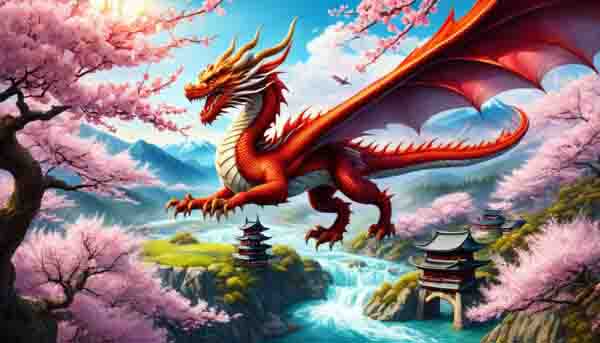
Have you heard? Japan’s mythical creatures are more numerous than its islands! With over 6,800 islands, that’s no small number. Yet, the mythical beasts of Japan and supernatural beings in Japan have an even bigger impact. Mischievous yokai monsters wander the lands of Japanese tales. Majestic legendary creatures in Japan reflect human virtues and flaws. These beings are not just old stories. They’re woven into mythical creatures in Japanese culture. They offer wisdom and a view into Japan’s spiritual heart.
The magic of creatures like the kitsune and komainu isn’t limited to quiet shrines or rural Japan’s hidden spots. They are found where old meets new. Japanese folklore is full of japanese folklore creatures that spark our imagination. They bring to life the mystique of an island nation rich in stories. These beings protect ancient knowledge and inspire today’s art. They create a tale that both charms and teaches.
Key Takeaways
- Japan’s folklore wealth includes many mythical beasts, surpassing the island count itself.
- These legends deeply influence Japanese culture, shaping spiritual and societal views.
- Yokai monsters and legendary creatures deeply impact literature, art, and religion in Japan.
- Even today, these mythical beings connect the past and present, affecting media, festivals, and daily life in Japan.
- This reverence shows Japan’s skill in preserving its history while adapting to modern times.
The Enigmatic Kitsune and Their Role in Japanese Mythology
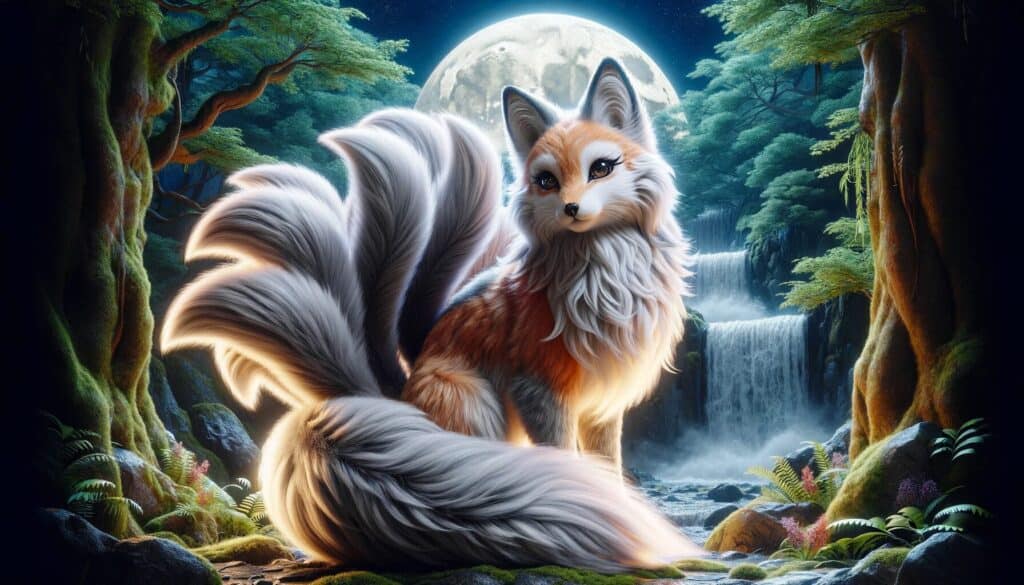
In Japanese mythology, the Kitsune is very special. These foxes are both playful tricksters and serious guardians. They are loved and well-known as mythical animals in Japanese mythology.
Trickster Spirits and Protectors of the Inari Deity
Kitsune have a big role in Shinto, related to Inari, the god of rice and wealth. They are messengers who keep evil away. Around rice fields and Inari shrines, you can see statues of these yokai spirits and monsters. They guard and bless agriculture and business.
The Nine-Tailed Fox: A Symbol of Wisdom and Power
The nine-tailed fox, or kyubi no kitsune, is a powerful symbol. These supernatural monsters of Japan show wisdom and a long life. The more tails they have, the stronger and smarter they are.
Shape-Shifting and Their Presence in Japanese Folklore
Kitsune are famous for being able to change their shape. They turn into people to interact with us, for good or bad reasons. This belief of moving between our world and the spiritual one makes Kitsune endlessly fascinating as yokai spirits and monsters.
Guardians at the Gates: Understanding Komainu
In the rich tapestry of legendary monsters of japan, komainu are prominent figures. They emerge from japanese folklore creatures tales. These majestic beings symbolize more than myths; they’re a tangible part of Japan’s sacred places. Their history mixes stories from distant lands, showcasing a blend of Korean to Egyptian influences in the mythical beasts of japan.
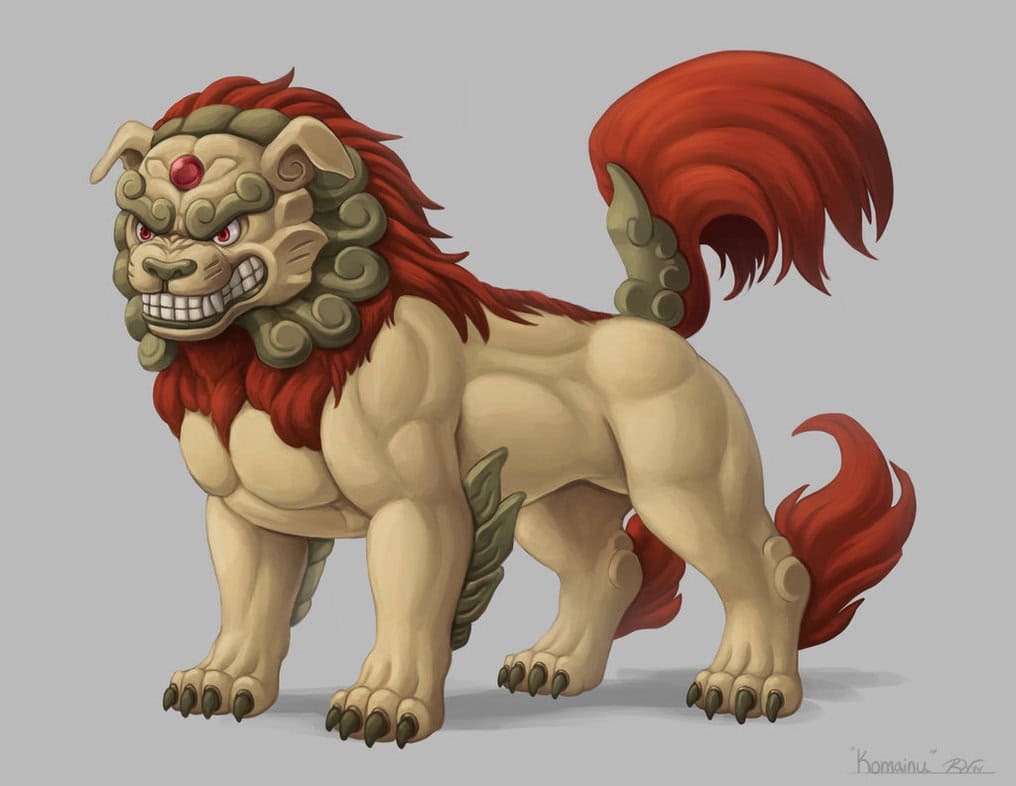
Komainu stand guard at many shrines and temples, serving as symbolic sentinels. One has its mouth open to ward off evil, while the other’s mouth is closed, keeping in joy. This tradition underscores the importance of balance. At places like Nara or Itsukushima Island, these figures command respect and bring peace.
- Intriguing origins tied to the Tang Dynasty
- Mouths poised in silent incantation to affect spiritual warfare
- Representations in diverse locations across Japan, from Nara to Itsukushima
- An amalgamation of cultural artistry influencing their form and significance
Paying tribute to these mythical beasts of japan reveals much about Japanese tradition. Here, myth blends with the real world. In this realm, komainu are honored symbols, part of a story filled with magic and history.
Yatagarasu: The Three-Legged Crow of Guidance
Japanese folklore is full of legendary creatures that still inspire today. Yatagarasu, the three-legged crow, stands out. It represents guidance and success within mythical creatures in Japanese culture. This magnificent crow connects the past with modern Japan. It shows how old and new traditions blend beautifully in this vibrant country.
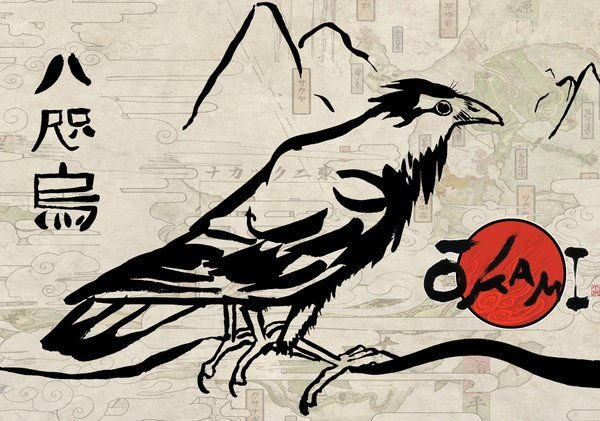
Emblem of Victory and the Divine Messenger
Yatagarasu is significant among yokai spirits and monsters. It symbolizes good luck and divine messages from the heavens. Known as a sign of victory and heavenly help, this legendary crow has deep meaning.
The Symbolism Behind Yatagarasu’s Three Legs
The mystery of Yatagarasu’s three legs represents heaven, earth, and humanity. These symbolize the connection between the universe and life. This symbolism shows the deep link between nature and humans in mythical creatures in Japanese culture.
Yatagarasu in Shintoism and Japanese Culture
Yatagarasu’s story is alive in Shintoism and Japanese cultural practices. It is revered as a legendary creature in Japan. Its symbol of unity and leadership even inspires Japan’s football team. They see it as a guide to success.
The Phoenix of Japan: The Hōō’s Auspicious Presence
In Japan’s world of mythical beasts, the Hōō shines brightly. It’s like the Japanese Phoenix, known for new beginnings. It represents a fire that ends one phase and starts another. This bird is special because it combines the real and magical worlds. This mix has amazed those who create art and build, for many years.
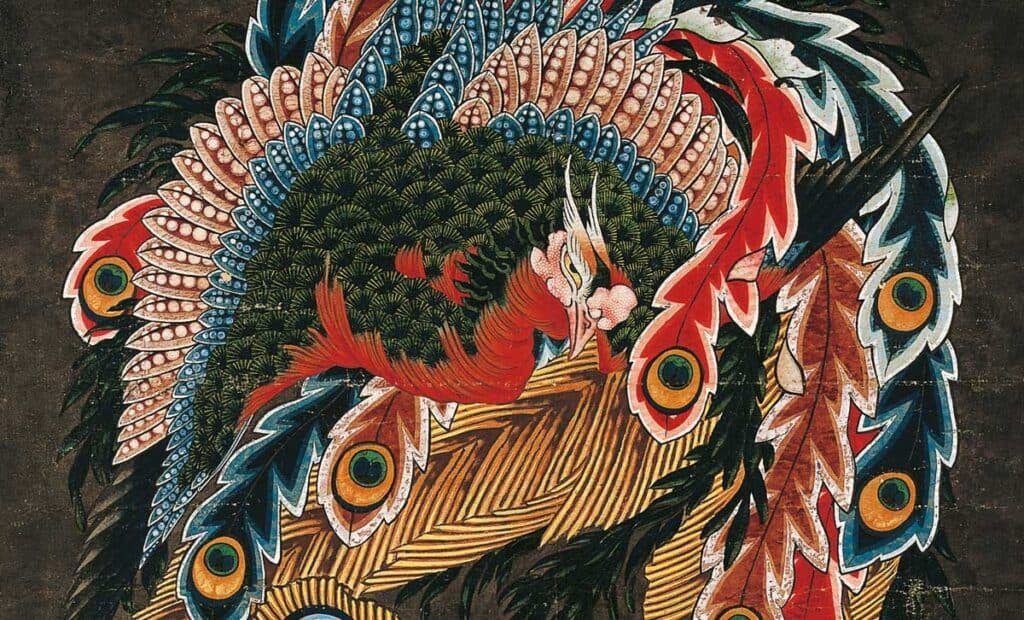
A Creature of Immortality and Peace
The Hōō symbolizes forever peace in Japanese culture. It’s not just any bird; it carries high values like kindness and truth. When the phoenix arrives, it’s a sign of a hopeful, fair future. It’s different from other legendary monsters of Japan because it brings good, watching over us with kindness.
Influence on Japanese Art and Architecture
The Hōō has deeply touched Japanese art and big buildings. It appeared in Katsushika Hokusai’s art, a famous name in ukiyo-e prints. The Byodoin Temple in Uji is a wonder, inspired by the bird. It shows how much Japan respects the phoenix, offering a story of growth to all who see it.
- The Hōō as a symbol of peaceful resurrection continues to be a poignant inspiration in the artistic world.
- Its presence in architectural designs connects the mortal sphere to the realm of the divine, celebrating the balance of natural elements.
- Through every embodiment, be it in sculpture, painting, or grand temples, the Hōō’s auspicious presence echoes the enduring spirit of Japanese tradition.
Kirin: The Mystical Hybrid Beast of Prosperity
In Japanese mythology, the Kirin shines as a beacon of goodness and fairness. It is deeply respected in Japanese culture, seen in stories and art. The Kirin symbolizes both new beginnings and the end of eras, bringing peace and wealth.

The Kirin blends features from different beings—dragon scales, a stag’s grace, and strong hooves. Unlike other yokai monsters, it loves peace and is known for its kindness. This creature prefers to give blessings instead of causing pain. It’s often celebrated in mythical creatures in Japanese culture.
- The Kirin as a beacon of peace, often appearing in folklore during times of prosperity and justice.
- Its association with longevity and celestial dignity, reflective of its storied origins in mythology.
- The impact of the Kirin on modern branding, such as the Kirin Brewery Company, infusing traditional symbolism into contemporary commerce.
The Kirin stands as a symbol of moral integrity among mythical creatures in Japanese culture. It’s seen as a guardian against misfortune, believed to bring luck and success. Being a cherished figure in mythical animals in Japanese mythology, it inspires awe and reminds us of Japan’s rich traditions and myths.
Hakujya: The White Snake of Fortune and Luck
In the realm of legendary monsters of Japan, the Hakujya is a unique figure. It brings a peaceful presence and is known for bringing good luck. This white snake is especially honored among Japan’s supernatural beings. Seeing it is not only amazing but also a sign of coming wealth and prosperity.
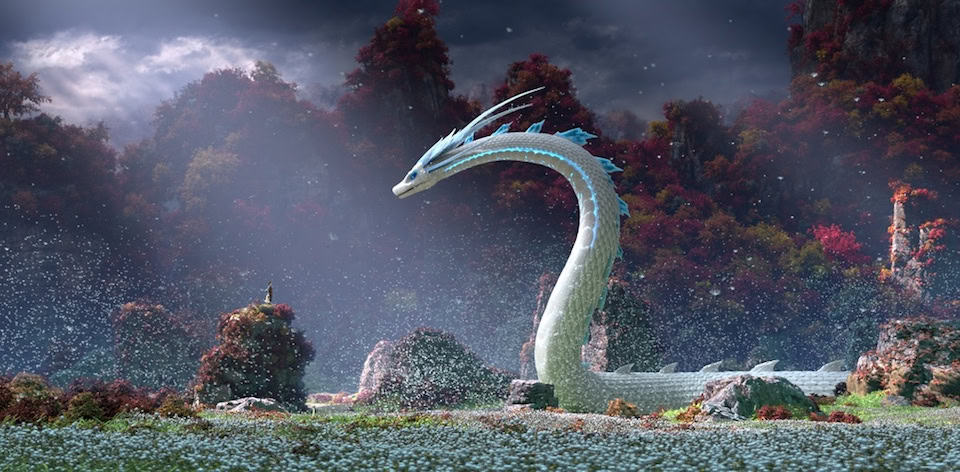
Linked to Benzaiten, the goddess of music and water flow, the white snake serves as her messenger. In Japan, meeting the white snake is seen as a stroke of fortune. This makes it a key symbol among the yokai spirits and monsters in Japanese stories.
- The white snake, or Hakujya, stands for growth and divine messages.
- It’s often shown with a dragon, symbolizing strength and wealth together.
- Seeing the Hakujya is thought to bring financial luck soon.
In stories of legendary monsters of japan, the Hakujya blends magic with reality. People carry its images as charms, hoping to draw wealth. The Hakujya shows the lasting impact of Japan’s yokai spirits and monsters. Their stories go beyond myth, impacting the daily lives of those who cherish these supernatural beings in Japan.
Mythical Beasts of Japan in Popular Culture
Supernatural monsters from Japan and mythical creatures in Japanese culture have caught the attention of people all over the world. They stand out in entertainment and media today. Yokai monsters, in particular, have gained popularity again through anime and manga. They attract fans with their deep stories and rich folklore.
The Pervasive Influence of Yokai Monsters in Anime and Manga
Anime and manga have become key ways to introduce yokai to audiences worldwide. Shows like “Demon Slayer” highlight epic fights between humans and demons, taking inspiration from old legends. These tales show that ancient myths still matter in our stories today.
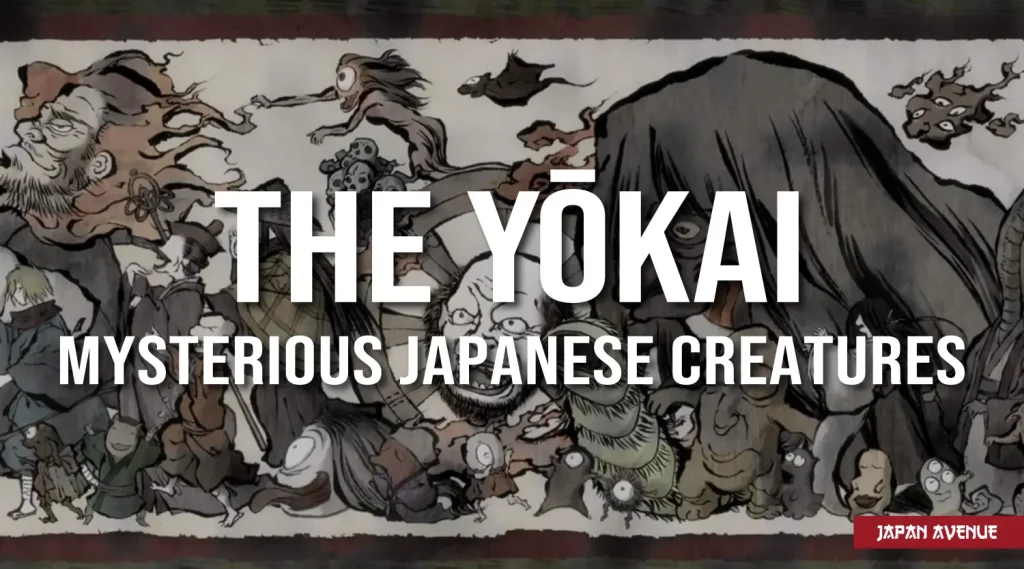
Mythical Beasts Finding a Place in Modern Media
Yokai monsters are now part of modern media, from their look to their stories. Companies use them in branding, and you can find yokai in movies and video games. They’re often heroes or mascots. Mixing old myths with today’s pop culture, this trend keeps our love for mysterious tales alive.
- Tanuki statues, often seen outside businesses, are believed to bring commercial success.
- Kitsune, or fox spirits, appear regularly in branding, symbolizing cleverness and cunning.
- Snack packaging features playful depictions of various yokai, making them a daily part of consumer culture.
The charm of yokai monsters and mythical creatures in Japanese culture continues to grow. It shows how traditional stories and digital technology can come together. This creates a space where supernatural tales can flourish in the modern world.
Conclusion
The journey into the world of mythical beasts of Japan teaches us to appreciate their impact on Japanese folklore creatures. These beings are part of the nation’s culture, showing us values and dreams. The respect for supernatural beings in Japan shows a mix of old and new, honoring stories while keeping them alive today.
As we discovered, the stories of legendary monsters of Japan are everywhere. They’re not just in old temples or at festivals. They’re also in anime, manga, and movies, showing their stories are timeless. Their place in modern art doesn’t lessen their meaning but broadens their message worldwide.
In the end, Japan’s mythical beasts are more than just folklore. They’re key to the nation’s identity, guiding ideas of right and wrong, and human complexity. Their legends prove Japan’s dedication to its history, blending into its culture’s fabric. Through sacred images and in pop culture, these creatures show a society that honors its past while embracing the future.
What are mythical beasts of Japan?
Mythical beasts of Japan are legendary creatures that feature prominently in Japanese folklore and mythology, often possessing supernatural abilities and symbolic significance.
What is the significance of mythical beasts in Japanese culture?
Mythical beasts play a vital role in Japanese culture, representing various aspects of nature, spirituality, and human experience. They are often revered as symbols of protection, wisdom, or warning.
What are some famous mythical beasts in Japanese folklore?
Some famous mythical beasts in Japanese folklore include the Kappa, Tengu, Kitsune, Yuki-onna, Oni, Kirin, Kasa-obake, Tanuki, and Dragon.
What is a Kappa?
Kappa are water-dwelling creatures known for their mischievous nature and unique appearance, including a bowl-shaped depression on their heads. They are often associated with rivers and ponds.
What is a Tengu?
Tengu are forest-dwelling spirits with long noses and wings, often depicted as protectors of mountains and forests. They are renowned for their martial prowess and magical abilities.
What is a Kitsune?
Kitsune are fox spirits with shape-shifting abilities and magical powers. They are associated with Inari, the god of rice, and are revered as messengers of good fortune or tricksters.
What is a Yuki-onna?
Yuki-onna, or “snow woman,” is a spirit associated with winter and snowstorms. She is often depicted as a beautiful yet deadly figure who can bring either death or salvation.
What is an Oni?
Oni are malevolent demons or ogres known for their fearsome appearance and association with punishment and disease. They are often depicted as wild, horned creatures.
What is a Kirin?
Kirin are mythical creatures resembling a mix of deer, dragon, and horse. They are symbols of good fortune and prosperity, often appearing as omens of great events.
What is the significance of dragons in Japanese mythology?
Dragons hold a significant place in Japanese mythology as symbols of power, wisdom, and protection. They are revered as divine beings associated with water, rain, and the emperor.
